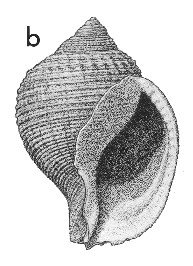
Revised descriptions of New Zealand Cenozoic Mollusca from Beu and Maxwell (1990)

 | Revised descriptions of New Zealand Cenozoic Mollusca from Beu and Maxwell (1990) | 
|
  (Pl. 48b): paratype, Upper Westmere Siltstone, Kai-Iwi, west of Wanganui, Castlecliffian (GNS; from a private collection) |
Beu & Maxwell (1990): Chapter 16; p. 353; pl. 48 b.
Synonymy: Galeodea (Galeoocorys) n. sp., Beu & Maxwell 1990, p. 353, pl. 48b; Galeodea plauta Beu 2008, p. 313, fig. 17E, G-J.
Classification: Cassidae: Cassinae
Description: Moderately large for genus (55 mm high), evenly oval, with low, conic spire, short, straight, open, weakly twisted anterior canal, and no fasciole. Sculpture of many prominent spiral cords, 5 on weakly convex sutural ramp, 1 more prominent than the others around the weak shoulder angle, 2-3 below shoulder on spire, and about 35 below shoulder on last whorl; the upper 4 interspaces below the shoulder each bear 1 intermediate weaker cord; cord at shoulder angle rendered finely nodulous by indistinct growth ridges which are otherwise smooth. Aperture large, oval, wide at anterior, more constricted above; outer lip weakly flared, lightly callused inside, with many low, indistinct, transverse ridges; inner lip rather thin, smooth except for sculpture showing through parietal glaze, narrowly spread over narrow umbilical chink. Protoconch small, mamillate, of 1.5 smooth whorls.
Comparison: Galeodea plauta is similar to G. sulcata (Kapitean-Opoitian, Westland; Waipipian, South Taranaki coast). Westland Kapitean-Opoitian specimens have a much thicker outer lip, wider spiral cords, and nodules continuing further below the periphery (present on four or five spiral cords) than in Castlecliffian-Recent shells, but the single South Taranaki Waipipian shell seen (Ohawe Beach, Hawera, in colln. F. D. Chambers) is intermediate in some characters between Castlecliffian and older specimens. G. plauta differs from the more common Opoitian-Recent species G. triganceae Dell in its wider shape, with a taller spire and a markedly wider aperture and, in particular, with many more, much more prominent spiral cords on the sutural ramp. The ramp bears only 5-7 low, closely spaced spiral threads and no primary spiral cords in G. triganceae, whereas it bears a median primary spiral cord and 3-5 prominent secondary spiral cords in G. plauta. G. plauta apparently is a member of a western New Zealand species group, and all fossil and Recent records of G. triganceae seem to be from eastern New Zealand. The depth records of Recent specimens of G. plauta suggest that this species has changed its habitat drastically since mid-Castlecliffian time.
Distribution: Off Ahipara, W Northland, 500 m (type of Galeodea plauta); Castlecliffian, Castlecliff, Wanganui (rare, 5 specimens known, all from Upper Westmere Siltstone); Recent, upper bathyal zone off western Northland only, in 290-500 m (rare, 3-4 specimens known).
Cite this publication as: "A.G. Beu and J.I. Raine (2009). Revised
descriptions of New Zealand Cenozoic Mollusca from Beu and Maxwell (1990). GNS
Science miscellaneous series no. 27."
© GNS Science, 2009
ISBN
978-0-478-19705-1
ISSN 1177-2441
(Included with a PDF facsimile file
copy of New Zealand Geological Survey Paleontological Bulletin 58 in CD version
from: Publications Officer, GNS Science, P.O. Box 30368 Lower Hutt, New
Zealand)